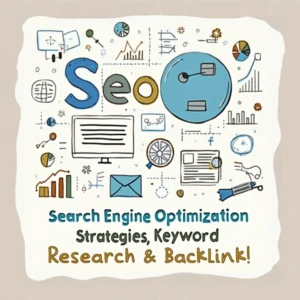In the competitive digital era, mastering Search Engine Optimization (SEO) is essential for any website aiming to rank higher in search engines and drive organic traffic. As a digital marketer with years of experience, I can attest that SEO is more than just a technicality; it’s an ongoing strategy that requires continuous refinement. In this post, I’ll break down some core concepts and actionable strategies that will not only help you understand SEO but also implement it effectively. Let’s dive deep into SEO strategies, keyword research, backlink building, meta tags, and on-page optimization.
What is Search Engine Optimization (SEO)?

At its core, Search Engine Optimization is the process of optimizing your website to rank higher on search engine results pages (SERPs). This involves a variety of tactics and best practices, from keyword research to enhancing the user experience. SEO is crucial because higher rankings lead to increased visibility, which translates to more traffic and, eventually, more conversions.
SEO is a broad field with several components, but let’s focus on some of the most effective strategies.
SEO Strategies: Building the Foundation
SEO strategies are the blueprint of any successful SEO campaign. These strategies include both on-page and off-page optimization techniques, and they should align with the goals of your website.
- Content Optimization: Content is king in SEO. SE give important to fresh, relevant, and high-quality content. Ensuring that your website offers content that addresses your audience’s questions and needs is essential for ranking well. Regular blog posts, product updates, and case studies are great ways to stay relevant.
For example, let’s you have a local bakery. By writing blog posts on topics like “5 Tips for Perfecting Your Cupcakes” or “The History of French Pastries,” you’ll appeal to both search engines and your customers.
- User Experience (UX): Google now prioritizes user experience as a ranking factor. Your website have easy navigate, load quickly, and be mobile-friendly. Tools like Google’s PageSpeed Insights can help you assess your website’s speed.
- Technical SEO: Beyond content and design, technical SEO is crucial. This includes optimizing the site’s architecture, ensuring your website is crawlable, and setting up structured data.
For example, adding schema markup can help search engines understand the context of your content, improving the chances of ranking higher.
Keyword Research: The Backbone of SEO
No SEO strategy can succeed without effective keyword research. Understanding what search terms your target audience uses when looking for products or services is key to driving traffic to your site.
How to Do Keyword Research:
- Use Keyword Research Tools: Tools like Google Keyword Planner, Ahrefs, or SEMrush can help you discover the best keywords to target. For example, if you’re running a digital marketing blog, keywords like “SEO tips” or “how to optimize your website” would be crucial.
- Focus on Long-Tail Keywords: These are longer, more specific phrases that often have lower competition. For example, instead of just targeting “SEO,” you could go for “SEO strategies for small businesses.”
- Analyze Competitors: Look at which keywords are driving traffic to your competitors.
Backlink Building: Enhancing Authority
Backlink building is one of the most effective ways to improve your website’s authority and ranking. Backlinks are essentially votes of confidence from other websites, signaling to Google that your content is valuable and trustworthy.
How to Build Backlinks:
- Guest Blogging: Writing articles for other blogs in your niche is a great way to get high-quality backlinks.
- Create Link-Worthy Content: Creating content that others will want to reference and share, such as in-depth guides, case studies, or original research, can naturally attract backlinks.
- Broken Link Building: Find broken links on other websites that are relevant to your niche and suggest your own content as a replacement. This method helps both the website owner and you.
A good example would be conducting a detailed study on the best SEO tools available and reaching out to bloggers who have mentioned “SEO tools” but have outdated links.
Meta Tags: Optimizing for Search Engines
Meta tags, particularly the title tag and meta description, play a pivotal role in SEO. Although they do not directly influence rankings, they are still essential because they impact click-through rates (CTR). A compelling title and description can make the difference between a click and a bounce.
Key Meta Tags to Optimize:
- Title Tag: This is the first thing search engines see. Make sure it is clear, concise, and includes your primary keyword. For example, “Best SEO Strategies for 2025 | Ahmad Afridi Digital Marketing.”
- Meta Description: This brief snippet summarizes your content. Make sure it is enticing and includes secondary keywords. Example: “Learn the advance SEO strategies, effective keyword research tips, & backlink building techniques to skyrocket your website rankings.”
On-Page Optimization: Fine-Tuning the Content
On-page optimization refers to the process of optimizing individual web pages to rank higher and earn more relevant traffic. It’s about making your content as easy to read, engage with, and understand for both users and search engines.
Key Elements of On-Page Optimization:
- Header Tags: Use H1, H2, and H3 tags to structure your content properly. This helps both search engines and users navigate your content. For example, an H1 tag for “SEO Strategies” and H2 tags for “Keyword Research” and “Backlink Building” ensures clarity.
- Internal Linking: Link to other relevant pages within your site. This helps Google crawl your website and also keeps users engaged longer.
- Image Optimization: Compress images for fast loading times, and add descriptive alt text, which helps search engines understand the content of the image.
- URL Structure: Keep your URLs short, descriptive, and keyword-rich. For instance, instead of “website.com/post1,” use “website.com/seo-strategies-2025.”
Conclusion
Search Engine Optimization is a dynamic, multifaceted discipline that requires a combination of SEO strategies, keyword research, backlink building, and on-page optimization to be successful. By staying updated on best practices and continuously refining your approach, you’ll be able to achieve better search engine rankings, increased traffic, and higher conversion rates.
Frequently Asked Questions about Search Engine Optimization (SEO)
1. What is SEO and why is it important?
Search Engine Optimization is the practice of optimizing your website to rank higher on search engines like Google, Bing, and Yahoo. It helps improve visibility, drive organic traffic to your site, and ultimately enhance the chances of conversions, such as sales or lead generation. SEO is crucial because higher rankings mean more people will find and visit your website, leading to increased brand awareness and business growth.
2. What are the key components of an SEO strategy?
An effective SEO strategy includes multiple components:
- Keyword Research: Identifying the terms and phrases users search for.
- On-Page Optimization: Enhancing individual web pages with relevant keywords, meta tags, internal links, and proper formatting.
- Backlink Building: Gaining high-quality backlinks from reputable websites to boost domain authority.
- Technical SEO: Ensuring your website is easily crawlable, mobile-friendly, and fast.
- Content Creation: Regularly producing high-quality, valuable content that aligns with your audience’s interests.
3. How does keyword research impact SEO?
Keyword research is foundational to SEO because it helps identify the search terms and phrases that your target audience uses. By targeting these keywords within your website content, you can increase the likelihood of your site appearing in relevant search results. Tools like Google Keyword Planner, SEMrush, and Ahrefs can help you find the best keywords for your website.
4. How do backlinks affect my website’s ranking?
Backlinks are links from other websites that direct traffic to your site. Search engines view backlinks as a sign of credibility and trust. The more high-quality backlinks you have from authoritative websites, the better your chances of ranking higher on search engine results pages (SERPs). Building backlinks through guest blogging, outreach, or creating shareable content can greatly improve your SEO.
5. What are meta tags, and how do they help SEO?
Meta tags, particularly title tags and meta descriptions, provide information to search engines and users about the content of a page. Though they don’t directly impact rankings, well-written meta tags can increase click-through rates (CTR), which is a ranking factor. Ensure that each page has a unique, descriptive title tag and a compelling meta description that encourages users to click.

